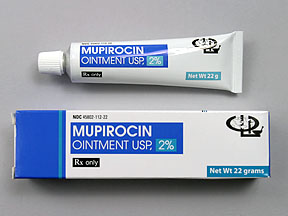
Mupirocin Coupons & Savings Card – Discount Prices from $2.68
Generic for: Centany, Centany at
My prescription
Edit
1GM of 2%, Mupirocin (1 Package)
Select pharmacy

CVS
$18.11
COUPON PRICE
Walmart
$2.68
COUPON PRICE
Albertsons
$3.94
COUPON PRICE
Walgreens
$3.94
COUPON PRICEMupirocin savings card
Show this card to your pharmacist
Walmart
$2.68
BIN
ID
PCN
GRP
019876
LH59B43455
CHIPPO
LHX
Powered by
Related RNA synthetase inhibitor antibiotics prescriptions
More prescriptions for skin infection
Related RNA synthetase inhibitor antibiotics prescriptions
More prescriptions for skin infection
Price history for Centany At (brand) & Mupirocin (generic)
1 Package, 1GM of 2%
Average retail price for Centany At
Average retail price for Mupirocin
Average SaveHealth price for Mupirocin
Our price history data is based on aggregated prescription data collected from participating pharmacies in America. Our prescription data updates daily to reflect the latest price changes. If you notice a missing data point, it means there wasn't sufficient data available to generate a monetary value for that date.
We analyzed Mupirocin prices for (1GM of 2%, 1 Package) over the last 12 months. The average retail price was $19.07, while the average price using the SaveHealth discount card was $3.24. That's a savings of approximately 83.01% when using our Mupirocin coupon.
Compared to the generic version, Centany At had an average price of $395.00 over the same time period. With the SaveHealth savings card, Mupirocin is 99.18% cheaper on average than Centany At.
*Retail prices are based on pharmacy claims data, and may not be accurate when we don't have enough claims.
Mupirocin dosage forms
Dosage Quantity Price from Per unit 1GM of 2% 1 Tube $2.68 $2.68 1GM of 2% 2 Tubes $2.86 $1.43 1GM of 2% 3 Tubes $3.04 $1.01 15GM of 2% 1 Tube $23.28 $23.28 15GM of 2% 2 Tubes $32.58 $16.29 15GM of 2% 3 Tubes $39.87 $13.29
| Dosage | Quantity | Price from | Per unit |
|---|---|---|---|
| 1GM of 2% | 1 Tube | $2.68 | $2.68 |
| 1GM of 2% | 2 Tubes | $2.86 | $1.43 |
| 1GM of 2% | 3 Tubes | $3.04 | $1.01 |
| 15GM of 2% | 1 Tube | $23.28 | $23.28 |
| 15GM of 2% | 2 Tubes | $32.58 | $16.29 |
| 15GM of 2% | 3 Tubes | $39.87 | $13.29 |
Mupirocin Warnings
The following safety information outlines important warnings and precautions related to the use of this medication. It is crucial to understand these details and discuss any concerns with your healthcare provider.
Severe Allergic Reactions: Although rare, some individuals may experience a severe allergic reaction to mupirocin, which could be life-threatening. If you notice symptoms such as a rash, hives, swelling, difficulty breathing, or signs of anaphylaxis, discontinue use immediately and seek emergency medical assistance.
Risk of Diarrhea from Clostridioides difficile Infection: Mupirocin, like other antibiotics, may alter the natural balance of bacteria in the gut, potentially leading to an overgrowth of Clostridioides difficile (C. diff) and resulting in diarrhea. This risk is minimal as mupirocin is primarily applied to the skin, resulting in limited absorption.
Resistance Development: Prolonged use of mupirocin can lead to the emergence of treatment-resistant strains of bacteria or fungi, making infections more challenging to treat. To avoid this, adhere strictly to the prescribed duration of treatment as directed by your healthcare provider.
Caution in Individuals with Kidney Issues (Ointment Only): The mupirocin ointment contains an inactive component that may become toxic if significantly absorbed through damaged skin. This is particularly concerning for individuals with kidney problems, as the kidneys are responsible for eliminating this substance from the body.
Please ensure you use mupirocin precisely as prescribed and consult your healthcare provider for any questions or if you experience adverse effects.
Mupirocin Side Effects
Common side effects:
- Headaches
- Burning or stinging at the application site
- Rash
- Nausea
Less common but important to monitor:
- Itching
- Skin irritation
- Dizziness
Serious side effects:
- Severe allergic reactions (rash, hives, swelling, trouble breathing)
- Serious intestinal condition due to C. difficile infection (persistent diarrhea, abdominal pain, blood or mucus in stool)
- New fungal or yeast skin infections
- Very serious allergic reaction (severe dizziness, difficulty breathing)
Mupirocin Interactions
Mupirocin is a topical antibiotic commonly used to treat certain skin infections. When using mupirocin, it's important to be aware of potential interactions to ensure its effectiveness and safety.
Concurrent Use with Other Topical Products
Avoid applying mupirocin simultaneously with other lotions, creams, or ointments on the same area of skin. Combining multiple topical products can dilute the antibiotic, reducing its effectiveness, and may increase the risk of skin irritation.
Intranasal Application
If you're using mupirocin intranasally (inside the nose), do not use it alongside other intranasal medications. The safety and effectiveness of combining mupirocin with other nasal treatments have not been established, and concurrent use may lead to reduced efficacy or increased side effects.
Systemic Drug Interactions
Mupirocin is minimally absorbed into the bloodstream when applied topically, making systemic drug interactions unlikely. However, always inform your healthcare provider about all medications, supplements, and herbal products you're currently using. This ensures they can provide personalized advice and monitor for any unexpected interactions.
Special Considerations
Kidney Function: Some mupirocin formulations contain polyethylene glycol (PEG). If applied to large areas of broken or damaged skin, PEG can be absorbed into the body and may affect kidney function, especially in individuals with existing kidney issues. Use mupirocin with caution in such cases and consult your healthcare provider for guidance.
Allergic Reactions: Be vigilant for signs of allergic reactions, such as rash, itching, swelling, dizziness, or difficulty breathing. If any of these occur, discontinue use and seek medical attention promptly.
By adhering to these guidelines and maintaining open communication with your healthcare provider, you can use mupirocin safely and effectively.
